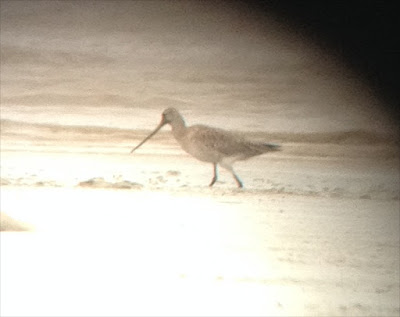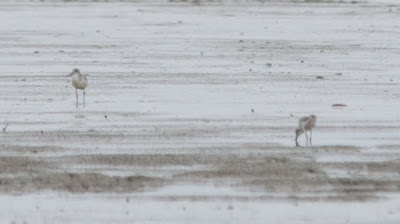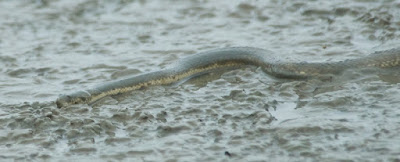Dave is an expert at shorebird identification, and the west coast of Peninsular Malaysia is one of the best places to see two of the rarest shorebirds in the world on their wintering grounds. My first request, therefore, was that we should try to find the Asian, or Asiatic, Dowitcher (Limnodromus semipalmatus) and Nordmann's Greenshank (Tringa guttifer), birds I had long wanted to see. For that, we had to go to a muddy stretch of coastline opposite the city of Georgetown, part of the Teluk Air Tawar-Kuala Muda Important Bird Area.
The tide conditions were not, alas, ideal, and the birds were a long way off....
...but they were there, and fortunately Dave had a telescope.
Even at a great distance, it was possible to identify birds - especially the ones that weren't shorebirds. Notice the Brahminy Kite (Haliastur indus) in the bottom photo.
Other non-shorebirds included a few Brown-headed Gulls (Chroicocephalus brunnicephalus).
Pond herons were about as well. Although identifying the three Asian species in non-breeding plumage is all but impossible, this one (holding what seems to be a quite substantial catch) is most likey to be a Chinese Pond Heron (Ardeola bacchus).
The shorebirds that came close to us were mostly Common Redshanks (Tringa totanus), which seemed to prefer to huddle at the upper tide line.
The really nifty birds stayed well out of reach, at least for me if not for Dave (who combines better photographic skills than mine with a howitzer-length telephoto; you really should read his account). Nonetheless, we did see four Asian Dowitchers (the lower photo was snapped with an iPhone through Dave's spotting scope) at what Dave call's "reasonable range". Well, I could tell what they were. The Asian Dowitcher is a considerably bigger and more godwit-like bird than the two dowitchers we see in North America, with a long, relatively heavy bill. It feeds in a typically dowitcher-like "sewing-machine" fashion; Dave's account has a nice video that shows this very well.
We saw Nordmann's Greenshanks as well, but even further out. However, even at this distance we were able to see the bird's two chief distinguishing marks: shorter legs, and a more sharply bicoloured bill, than in its nearest (and far commoner) relative the Common Greenshank (Tringa nebularia). So tally ho, even from a long way off!
There were things to see nearer to the tideline, but they were, mostly, not birds. Fiddler crabs scuttled over the mudflats...
... joined by mudskippers of (presumably) various species. This is the common Blue-spotted mudskipper (Boleophthalmus boddarti).
In pursuit of the crabs (and the mudskippers) was a Dog-faced Watersnake (Cerberus rynchops), a reptile that does much better on brackish mudflats than on land. It apparently pursues mudskippers into their burrows, and even (so they say) baits small fishes with its tail.
An assortment of shells littered the upper tide line, mostly (at least in this photograph) the remains of ark clams (Family Arcidae). Arcids are usually known as cockles in Malaysia, but true cockles belong to a different family, Cardiidae.
This strange object clinging to a stone gave me some pause, but it appears to be an onch slug (Family Onchidiidae). Onchidiids, though they live in (or by) the sea and lack shells, are not sea slugs but air-breathing relatives of the snails one finds in gardens. You can see this one's antennae protruding from beneath its mantle at the bottom of the photograph.
At length the birds decided to move on, flying up against the urban background of Penang Island, and we decided to do the same.
Our next stop was a patch of reeds, home to what may be Malaysia's most recent avian arrival. The Manchurian Reed Warbler (Acrocephalus tangorum) is a local and declining species, only recently split from the Paddyfield Warbler (A. agricola). It has not made it onto the official Malaysian list yet, but it has now been found wintering at two sites on the Peninsula. I failed to get a photo of it, so again I'll have to refer you to Dave - but at least I saw it, which is more than I can say for the persistently-calling, but invisible, Pallas's Grasshopper Warblers (Locustella certhiola) at the same site.
I had better luck with this fine Eastern Imperial Eagle (Aquila heliaca), a bird I had only seen previously at the other end of its range, in the Tatra Mountains of Slovakia.
This Brown Shrike (Lanius cristatus), photographed along the roadside on the way to our next stop, was considerably more cooperative.
Other roadside creatures included an Oriental Garden Lizard (Calotes versicolor), common here but a species I do not see in Sarawak (though I gather it has been introduced to Brunei).
Brachythemis contaminata is a common dragonfly on the Malay Peninsula and Singapore, but it is another species apparently absent from Borneo. It tolerates polluted waters (as Dave pointed out, its specific name contaminata reflects its tastes in habitat, and it is commonly known as the Ditch Jewel).
This is a female.
This tiny Agriocnemis femina, an immature male, turned up in a men's washroom stall. As I don't normally carry my camera gear into the toilet I had to make do with my iPhone - and the fact that the result is identifiable I put down to pure serendipity.









































No comments:
Post a Comment